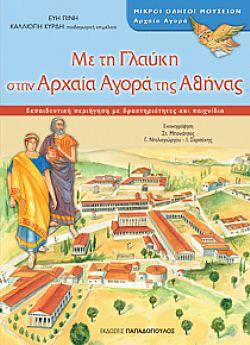Title of the work
Country of the First Edition
Country/countries of popularity
Original Language
First Edition Date
First Edition Details
Evi Pini & Kalliopi Kyrdi, Με τη Γλαύκη στην Αρχαία Αγορά της Αθήνας [Me tī Gláfkī stīn Archaía Agorá tīs Athī́nas]. Short Museum Guides [Μικροί Οδηγοί Μουσείων (Mikroí Odīgoí Mouseíon)] (Series), Athens: Papadopoulos Publishing, 2008, 40 pp.
ISBN
Genre
Illustrated works
Instructional and educational works
Puzzles and games
Target Audience
Children (6+)
Cover

Courtesy of the Publisher.
Author of the Entry:
Katerina Volioti, University of Roehampton, Katerina.Volioti@roehampton.ac.uk
Peer-reviewer of the Entry:
Susan Deacy, University of Roehampton, s.deacy@roehampton.ac.uk
Elżbieta Olechowska, University of Warsaw, elzbieta.olechowska@gmail.com

Kalliope Kyrdi (Author)
Kalliope Kyrdi studied Law and Pedagogy at the University of Athens, and has worked in primary school education. Kyrdi has been responsible for cultural matters in the 1st Directorate of Primary Education, Athens, since 2007.
Source:
Profile at the epbooks.gr (accessed: June 27, 2018).
Bio prepared by Katerina Volioti, University of Roehampton, Katerina.Volioti@roehampton.ac.uk

Evi Pini (Author)
Athens-born Evi Pini studied Archaeology at the Aristotle University of Thessaloniki. Pini has been working for the Greek Ministry of Culture since 1990, specialising in children’s educational programmes.
Sources:
Information about the Author, see here (accessed: June 26, 2018).
Bio prepared by Katerina Volioti, University of Roehampton, Katerina.Volioti@roehampton.ac.uk
Translation
English: Glafki at the Athenian agora. Short Museum Guides, trans. Olympia Theofanopoulou, Athens: Papadopoulos Publishing, 2010, 64 pp.
Summary
The opening page, entitled “instead of a preface,” explains that the book is about an explorative journey to the past, for which teachers and parents can prepare children before visiting the Agora. A talking bird guides children throughout the book. Appropriately, for Athens, the bird is an owl called “Glafki”, and we are given information about its symbolism in ancient Greece and about owls nesting in the Acropolis today. An illustration with a reconstructed view of the Agora from the 2nd century AD with buildings from different periods is helpful since any visitor to the Agora encounters many layers of ancient buildings.
To help with gap-filling, Glafki gives us a chronological timeframe, from Neolithic times to the end of the Classical period. The stress is in the 5th century BCE, for which Glafki offers more dates of historical “landmarks” that affected Classical Athens. Children’s learning about the Agora starts with daily-life events rather than with the affairs of the state. The workings of democracy feature later on in the book. Children are asked to observe a black-figured vase scene from a blacksmith’s workshop and imagine that such a workshop operated in a Classical Agora.
As children enter the Museum, the objectives of their exploratory journey change.
Children now need to observe small finds rather than going back in time and envisaging ancient people’s interactions with one another and with the Agora’s physical and built environment. Glafki takes us to showcases with ceramic finds, and children pay attention to a red-figured kylix and a black-figured fragmentary krater. The latter, a masterpiece by Exekias showing Herakles’ procession to Olympos and name inscriptions for gods, offers an opportunity for a brief reference to mythology.
The aftermath of the visit is several interactive activities, including making ancient objects using plasticine, clay, and cans, which children can complete “at home and at school." At the end, children are asked to practice their creative writing skills by describing what they would see if they were at the Agora one morning in antiquity. Once again, we have a journey back in time and space. The book closes with answers to previous pages' questions, which is much needed as some exercises may be difficult for very young children. On the last page, we have Glafki’s reading list, which features works by Anglophone scholars and details about the book’s illustrations.
Analysis
The Athenian Agora is a large archaeological site with a museum housed in the Stoa of Attalos. This is the only guide in the series translated into English, perhaps targeting American visitors to the Agora. There is a strong link between the Agora and the American School of Classical Studies in Athens. The American excavations of the Agora commenced in 1931*. The book’s content is exceptionally rich, offering historical and archaeological information, illustrations (and reconstructions) of artifacts and buildings, and exercises that help children’s learning. The three illustrators have done a superb job with their accurate drawings of artworks and buildings.
In line with the book’s objective to make children appreciate ancient experience(s), the emphasis is on what people’s frequentation of Classical Agora entailed. Thus, children are encouraged to think about who visited the Agora (mostly males), what people saw in terms of buildings and trees, and the range of activities there (including religious processions).
Subsequent pages are more heavily laden with material about public buildings, monuments, democratic institutions, and the level of knowledge acquisition here is relatively high. Children will need to apply this knowledge in deciding who can hold office by reading five senators’ statements. The senators’ garments here may recall those of Roman officials, especially as known from Hollywood films. There will be more on magistrates and voting in the book once children visit the Museum of the Athenian Agora. Prior to that, and presumably, while children are still in the archaeological site, there is a presentation of the Hephaisteion, which is shown in reconstruction, and of the gods Hephaistos and Athena Ergane. Mythological context is not provided here. The description of the stoas entails accurate information about their function and appearance, ancient and modern.
Further Reading
Information about the book at epbooks.gr, published 15 September 2010 (accessed: August 2, 2018).
Addenda
Published in English (translated from Greek by Olympia Theofanopoulou).
Illustrations by Stamatis Bonatsos.
The entry is based on Evi Pini & Kalliopi Kyrdi, Glafki at the Athenian agora. Short Museum Guides, trans. Olympia Theofanopoulou, Athens: Papadopoulos Publishing, 2010, 64 pp.


